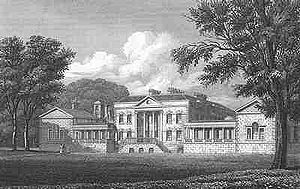
Carclew House
Encyclopedia

Cornwall
Cornwall is a unitary authority and ceremonial county of England, within the United Kingdom. It is bordered to the north and west by the Celtic Sea, to the south by the English Channel, and to the east by the county of Devon, over the River Tamar. Cornwall has a population of , and covers an area of...
, United Kingdom
United Kingdom
The United Kingdom of Great Britain and Northern IrelandIn the United Kingdom and Dependencies, other languages have been officially recognised as legitimate autochthonous languages under the European Charter for Regional or Minority Languages...
. It was situated at approximately three miles north of Falmouth
Falmouth, Cornwall
Falmouth is a town, civil parish and port on the River Fal on the south coast of Cornwall, England, United Kingdom. It has a total resident population of 21,635.Falmouth is the terminus of the A39, which begins some 200 miles away in Bath, Somerset....
.
Carclew House was rebuilt in the 18th century and again in the early 19th century but was destroyed by fire in 1934.
Design and construction
The original house and estateEstate (house)
An estate comprises the houses and outbuildings and supporting farmland and woods that surround the gardens and grounds of a very large property, such as a country house or mansion. It is the modern term for a manor, but lacks the latter's now abolished jurisdictional authority...
were purchased by a wealthy merchant
Merchant
A merchant is a businessperson who trades in commodities that were produced by others, in order to earn a profit.Merchants can be one of two types:# A wholesale merchant operates in the chain between producer and retail merchant...
William Lemon
William Lemon
Sir William Lemon, 1st Baronet was a Member of Parliament for Cornish constituencies from 1770 to 1824, a total of 54 years.-Parental family:...
(1696–1760) circa 1739. Lemon's town house in Truro had been designed by the architect Thomas Edwards, and it was again to Edwards that Lemon turned to substantially increase and modernise his new country house Carclew.
Work began in 1739, the enhancement to the mansion
Mansion
A mansion is a very large dwelling house. U.S. real estate brokers define a mansion as a dwelling of over . A traditional European mansion was defined as a house which contained a ballroom and tens of bedrooms...
included flanking the main block with colonnade
Colonnade
In classical architecture, a colonnade denotes a long sequence of columns joined by their entablature, often free-standing, or part of a building....
s terminated by small pavilion
Pavilion (structure)
In architecture a pavilion has two main meanings.-Free-standing structure:Pavilion may refer to a free-standing structure sited a short distance from a main residence, whose architecture makes it an object of pleasure. Large or small, there is usually a connection with relaxation and pleasure in...
s in the fashionable Palladian manner, the design was similar in appearance to drawings of Palladio's planned Villa Ragona.
Enlargement
At the beginning of the 19th century William Lemon's grandson Sir William LemonWilliam Lemon
Sir William Lemon, 1st Baronet was a Member of Parliament for Cornish constituencies from 1770 to 1824, a total of 54 years.-Parental family:...
(1748–1824) had the house expanded further. He employed the architect William Wood (1746–1818) to create new wings in the place of the pavilions designed by Edwards. Work began in 1799 with the east wing being built in 1800 and the west wing in 1802. The wings were linked to the corps de logis
Corps de logis
Corps de logis is the architectural term which refers to the principal block of a large, usually classical, mansion or palace. It contains the principal rooms, state apartments and an entry. The grandest and finest rooms are often on the first floor above the ground level: this floor is the...
by raised colonnaded connecting wings on the site of Edwards' original colonnades.
Sir Charles Lemon
Charles Lemon
Sir Charles Lemon, 2nd Baronet Lemon of Carclew was a British Member of Parliament for several constituencies and a baronet.-Service in Parliament:...
was amongst the first people in England to receive and grow rhododendron
Rhododendron
Rhododendron is a genus of over 1 000 species of woody plants in the heath family, most with showy flowers...
seed from Sir Joseph Hooker
Joseph Dalton Hooker
Sir Joseph Dalton Hooker OM, GCSI, CB, MD, FRS was one of the greatest British botanists and explorers of the 19th century. Hooker was a founder of geographical botany, and Charles Darwin's closest friend...
, who had sent seed directly to Carclew House from his Himalayan expedition of 1848–1850. Rhododendron arboretum specimen at Carclew, planted ca. 1850 by Sir Charles became one of the most famous in Cornwall. By 1928 it is about 35 feet high.
1934 fire
In 1934 Carclew was destroyed by fire and today just a few ruins are visible of what was once one of Cornwall's great houses. The terracedTerrace (gardening)
In gardening, a terrace is an element where a raised flat paved or gravelled section overlooks a prospect. A raised terrace keeps a house dry and provides a transition between the hard materials of the architecture and softer ones of the garden.-History:...
gardens complete with their water fountain
Fountain
A fountain is a piece of architecture which pours water into a basin or jets it into the air either to supply drinking water or for decorative or dramatic effect....
s and cascades
Waterfall
A waterfall is a place where flowing water rapidly drops in elevation as it flows over a steep region or a cliff.-Formation:Waterfalls are commonly formed when a river is young. At these times the channel is often narrow and deep. When the river courses over resistant bedrock, erosion happens...
remain and are privately owned and not open to the public.

